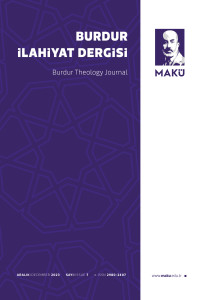Öz
Sûfîler tasavvufun bir hâl ilmi olduğunu söyler. Bizzat tecrübeyi ihtivâ eden bu hâl ilminin yazılmasının her dönemde zor olduğunu söyleyebiliriz. Çünkü tasavvuf metni yazıcılığını tecrübe eden sûfî tarafından mı yoksa dışarıdan değerlendirilerek mi yazılmalı tartışmaları karşımıza çıkmaktadır. Bununla beraber hangi metinler tasavvuf eserleri içinde kabul edileceği başlıca sorunlar arasında yer alır. Nitekim bu problemler çerçevesinde Osmanlı modernleşme döneminde yapılan yenilikler tasavvuf metinleri üzerinde de etkisini göstermiştir. Tanıtmaya çalışacağımız eser Osmanlı’nın son Cumhuriyet’in ilk dönemlerini kapsayan süreçte “yeni tasavvuf tarihi” yazıcılığından bahseder. Çalışmanın Giriş kısmında konusu, kapsamı ve literatür değerlendirmesini yapan yazarın eseri üç bölümden oluşmaktadır. Birinci bölümde Osmanlı modernleşmesinin tasavvuf tarihi yazıcılığına etkilerini dikkate alarak dönem içindeki problemleri, klasik dönemden ayrılan yeni uygulamaları aktarır. İkinci bölümde kronolojik düzeni dikkate alarak Osmanlı modernleşme döneminde tasavvufla irtibatlı olan müelliflerin kitap, makale ve risaleleri üzerinden tasavvuf tarihi yazıcılığının temel metinlerini takdim eder. Son bölümde ise tasavvufun menşei ve etimolojisi, konusu, yöntemi, maksadı ve meşrûiyet arayışı gibi genel meseleleri Osmanlı modernleşme dönemine taşıyarak dönemin müelliflerinin görüşleri üzerinden ele almaktadır. Yazar eserini Osmanlı modernleşme döneminde tasavvuf tarihi yazıcılığında yaşanan yenilik ve değişimleri sınırlandırdığı dönem ile inceleyerek sonuçlandırır. Bu çalışmada, Giriş, Üç Bölüm ve Sonuç’tan oluşan Osmanlı’dan Cumhuriyet’e Tasavvuf Tarihi Yazıcılığı (1910-1933) adlı eserin tanıtılması amaçlanmıştır. Bu amaç çerçevesinde eserin tahlili yapılarak literatüre katkısı değerlendirilecektir.
Anahtar Kelimeler
Kaynakça
- (Kitap İncelemesi türünde bir çalışma olduğu için kaynakça eklenmemiştir)
Muammer CENGİZ, Sufi History Writing from the Ottoman Empire to the Republic (1910-1933), Divinity Publications.
Öz
Sufis say that Sufism is a science of state. We can say that it is difficult to write about this science of state, which includes personal experience, in every period. Because we encounter debates about whether it should be written by a Sufi who has experienced Sufi writing or by being evaluated from outside. However, which texts will be accepted as Sufi works are among the main problems. As a matter of fact, within the framework of these problems, the innovations made during the Ottoman modernization period also had an impact on Sufi texts. The work we will try to introduce talks about the writing of the "new history of Sufism" in the period covering the first periods of the late Ottoman Republic. The work of the author, who evaluates the subject, scope and literature in the Introduction part of the study, consists of three parts. In the first chapter, he takes into account the effects of Ottoman modernization on Sufi historiography and conveys the problems during the period and new practices that differ from the classical period. In the second part, taking into account the chronological order, it introduces the basic texts of Sufi historiography through the books, articles and treatises of authors who were related to Sufism during the Ottoman modernization period. In the last chapter, it deals with general issues such as the origin and etymology of Sufism, its subject, method, purpose and search for legitimacy, through the views of the authors of the period, by carrying it to the Ottoman modernization period. The author concludes his work by examining the innovations and changes in Sufi historiography during the Ottoman modernization period with the period he limits. In this study, it is aimed to introduce the work titled Sufi Historical Writing from the Ottoman Empire to the Republic (1910-1933), which consists of an Introduction, Three Chapters and a Conclusion. Within the framework of this purpose, the work will be analyzed and its contribution to the literature will be evaluated.
Anahtar Kelimeler
Kaynakça
- (Kitap İncelemesi türünde bir çalışma olduğu için kaynakça eklenmemiştir)
Ayrıntılar
| Birincil Dil | Türkçe |
|---|---|
| Konular | Tasavvuf |
| Bölüm | Kitap İncelemesi |
| Yazarlar | |
| Yayımlanma Tarihi | 28 Aralık 2023 |
| Gönderilme Tarihi | 25 Eylül 2023 |
| Yayımlandığı Sayı | Yıl 2023 Sayı: 7 |
Burdur İlahiyat Dergisi Creative Commons Atıf-GayriTicari 4.0 Uluslararası Lisansı (CC BY NC) ile lisanslanmıştır.


